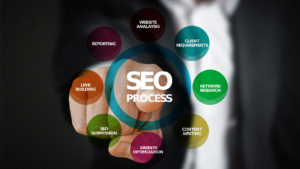Checklist: 7 Key On-Page SEO Elements for Better Content Optimization

1. Title Tag
The title tag is a crucial element of on-page SEO, significantly influencing both user experience and search engine rankings. Positioned within the head section of a webpage’s HTML, the title tag serves as the clickable headline in search engine results.
Crafting a compelling and relevant title tag not only helps to attract clicks but also provides search engines with a clear understanding of the page’s content. It is advisable to keep the title concise, typically under 60 characters, and to incorporate primary keywords naturally.
By doing so, you enhance the page’s visibility and relevance, ultimately driving more traffic to your site.
2. Page URL
When you have a good page URL, your site will rank higher in search engine results pages (SERPs) and be more likely to get found by potential customers.
Your site’s URL is what people see when they visit your website. The first step in ensuring your site has a high-quality URL to research what keywords are associated with that name or phrase.
You can use keyword research to find the right keywords for your business or product.
The most important part of keyword research is understanding the competition and what words they target with their marketing campaigns. Once you know the keywords you want to target, it’s time to write them down!
3. Meta Descriptions
Meta descriptions are important for a site’s overall search engine optimisation (SEO) effort. They allow your site’s visitors to easily find what you have to offer by providing a brief, descriptive overview of your item or service.
Meta descriptions must be comprehensive and relevant, containing all the information required to decide whether to include your product or service in a search engine listing.
4. H1 Tags

Key keyword research is important for any online content strategy.
H1 tags are an effective way to identify and target key audience keywords. With well-placed H1 tags, your content will be seen by more people and be more likely to reach your target audience.
By targeting the right keywords, you can improve the overall quality of your website or blog posts.
Use H1 tags strategically to make sure all of your content is covered in a search engine optimisation (SEO) friendly manner.
5. Keywords

One of the most important on-page SEO elements is keywords. When you optimise your content for SEO, you want to make sure that all of your keywords are included in the article’s title, meta descriptions, and other text tags.
If you don’t include keywords in your content, then your site will likely rank lower in SERPs and get fewer visits from search engines. You should also make sure that each keyword is properly defined and mapped to relevant backlinks.
Keep a keyword research tool on hand to ensure that your keywords are being used effectively.
6. Images
Images play an important role in content optimisation. They help you present information in a way that is easy to understand and search engine friendly.
To improve your images, use keyword-rich titles and descriptions. Use keywords liberally throughout your content, and make sure they are included in all tags and metadata of your pages.
Check for quality Guidelines when uploading images to ensure they are correctly formatted and created with high-quality graphics standards in mind. These guidelines can be found at Google, Bing, Yahoo! etc.
7. Internal And External Links

Internal Links are the most important aspect of on-page SEO for content optimisation. By using internal links, your website can show up higher in search engines for those looking for information about your business.
Additionally, external links help improve the overall quality of your website because they provide further exposure to what you have to offer.
External Links are just as important as Internal Links.
External links also play an important role in on-page SEO; by placing them near the top of your page, you will be more likely to see them when someone is searching for web content related to your business.
Additionally, external links help improve the visibility of your website and make it easier for potential customers to find what they need quickly and easily.
Conclusion
In conclusion, regarding on-page SEO elements, it is important to consider all of the different factors that can affect a website’s ranking. Some of these factors include site traffic, user experience, and search engine rankings.
By understanding these factors and implementing the correct SEO strategies, a website can improve its ranking and reach more customers.
Was this article helpful? Let us know in the comment.
FAQ
What are the on-page SEO elements that should be included on a website?
It is important to include TITLES, HEADINGS, and LINKS in your website’s SEO elements. Titles should be no longer than 250 characters and placed at the top of your website’s page.
Headings should be no more than 12 words and should be placed at the beginning or end of a sentence.
Links should lead to other websites that you think would be interesting in your website.
Why should you use on-page SEO elements?
When you are looking to rank higher in search engines, it is important that you use on-page SEO elements. Using these elements will help your website stand out from the rest and receive better visibility.
Here are two reasons why you should use on-page SEO elements:
- You can improve the overall look of your website. When your website has an ugly or cluttered design, it will not look as good when searched for online. You can improve this by using keywords in your title tags, meta descriptions, and other places where people might see them.
- You can improve the usability of your website. Another reason to use on-page SEO elements is that users may need help finding specific content on your website.
What are the best on-page SEO elements for content creators
One of the best on-page SEO elements for content creators is good titles. The titles help pull in readers and make sure they are focused on your article.
Title tags are another great way to create a focus on your topic.
Additionally, using keyword-rich titles will help you rank higher for your articles.




